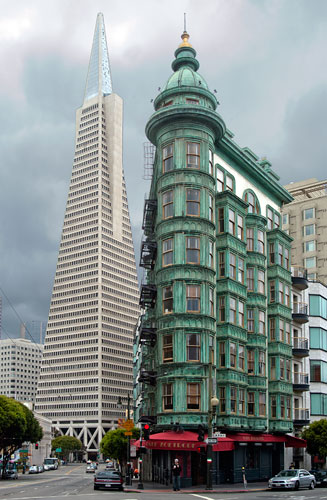San Francisco Landmarks

The Transamerica Pyramid stands where the
Montgomery Block once stood. The tan building,
just visible in the background on the right,
stands where the International Hotel once stood.
26 May 2008
(Click Photo to Zoom)
Sentinel Building
AKA Columbus Tower
AKA Coppola's Cupola
916-920 Kearny at Columbus
Financial District
Built 1907
The Sentinel Building, designed by Salfield and Kohlberg, is a flatiron building clad in white tile and copper. Construction was begun before the 1906 Earthquake and Fire. The framing survived the disaster, and the building was completed in 1907. The top floor housed the real estate brokerage of Political boss Abe Ruef after his release from San Quentin State Prison on charges of graft.




Rob Moor, a Dutch-born businessman who saved and restored the historic Sentinel Building at Columbus Avenue and Kearny Street,
died of pneumonia on May 22 at his home at Yardley, Pa. He was 85.
When [the Moors] arrived in San Francisco [in 1957], architect Henrick Bull, who designed a ski house for them in the Sierra, advised
them to purchase the Sentinel Building, a late Victorian steel-framed "flatiron" structure, surmounted by a copper dome, which was
threatened with destruction at a time when there was little interest in architectural preservation.
Yet the nine-story Sentinel was an authentic landmark on both historical and aesthetic counts because it had been built just before
the 1906 earthquake and fire by the notorious political boss Abe Ruef, who later went to San Quentin for his transgressions.
The Sentinel survived the quake and fire, and was put right again. But it had deteriorated badly (although Enrico Banducci's hungry i
nightclub flourished in the basement) by the time the Moors bought it in 1958 as an investment and renamed it Columbus Tower.
They never had cause to regret the stylish restoration by Bull, and they sold it at a profit 1 1/2 years later to a successful
young singing group called the Kingston Trio. The Trio in turn sold it to Francis Ford Coppola, who changed its name back to the Sentinel
and has his office there today. The building is now an official landmark.